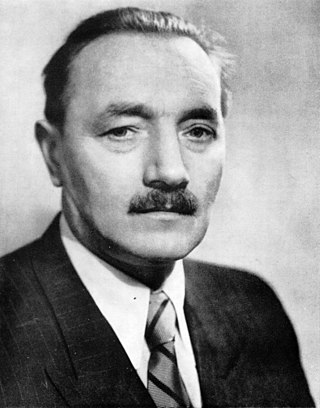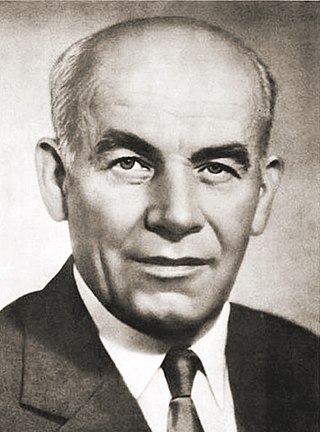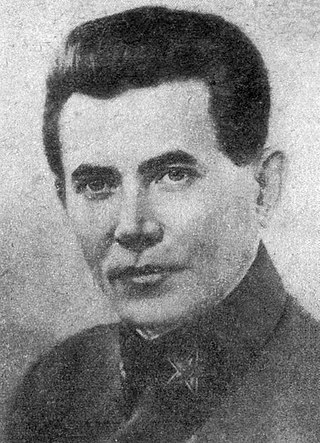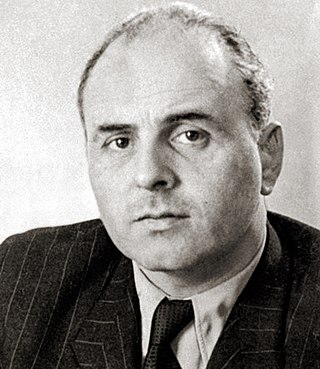Related Research Articles

Marie Salomea Skłodowska–Curie was a Polish and naturalized-French physicist and chemist who conducted pioneering research on radioactivity. She was the first woman to win a Nobel Prize, the first person to win a Nobel Prize twice, and the only person to win a Nobel Prize in two scientific fields. Her husband, Pierre Curie, was a co-winner of her first Nobel Prize, making them the first-ever married couple to win the Nobel Prize and launching the Curie family legacy of five Nobel Prizes. She was, in 1906, the first woman to become a professor at the University of Paris.

Pierre Curie was a French physicist, a pioneer in crystallography, magnetism, piezoelectricity, and radioactivity. In 1903, he received the Nobel Prize in Physics with his wife, Marie Skłodowska–Curie, and Henri Becquerel, "in recognition of the extraordinary services they have rendered by their joint researches on the radiation phenomena discovered by Professor Henri Becquerel". With their win, the Curies became the first ever married couple to win the Nobel Prize, launching the Curie family legacy of five Nobel Prizes.

Bolesław Bierut was a Polish communist activist and politician, leader of the Polish People's Republic from 1947 until 1956. He was President of the State National Council from 1944 to 1947, President of Poland from 1947 to 1952, General Secretary of the Central Committee of the Polish United Workers' Party from 1948 to 1956, and Prime Minister of Poland from 1952 to 1954. Bierut was a self-educated person. He implemented aspects of the Stalinist system in Poland. Together with Władysław Gomułka, his main rival, Bierut is chiefly responsible for the historic changes that Poland underwent in the aftermath of World War II. Unlike any of his communist successors, Bierut led Poland until his death.

Irène Joliot-Curie was a French chemist, physicist and politician, the elder daughter of Pierre Curie and Marie Skłodowska–Curie, and the wife of Frédéric Joliot-Curie. Jointly with her husband, Joliot-Curie was awarded the Nobel Prize in Chemistry in 1935 for their discovery of induced radioactivity, making them the second-ever married couple to win the Nobel Prize, while adding to the Curie family legacy of five Nobel Prizes. This made the Curies the family with the most Nobel laureates to date. She was also one of the first three women to be a member of a French government, becoming undersecretary for Scientific Research under the Popular Front in 1936. Both children of the Joliot-Curies, Hélène and Pierre, are also prominent scientists.

Władysław Gomułka was a Polish communist politician. He was the de facto leader of post-war Poland from 1947 until 1948, and again from 1956 to 1970.

Jean Frédéric Joliot-Curie was a French physicist and husband of Irène Joliot-Curie, with whom he was jointly awarded the Nobel Prize in Chemistry in 1935 for their discovery of Induced radioactivity. They were the second ever married couple, after his wife's parents, to win the Nobel Prize, adding to the Curie family legacy of five Nobel Prizes. Joliot-Curie and his wife also founded the Orsay Faculty of Sciences, part of the Paris-Saclay University.

Nikolai Ivanovich Yezhov was a Soviet secret police official under Joseph Stalin who was head of the NKVD from 1936 to 1938, during the height of the Great Purge. Yezhov organized mass arrests, torture and executions during the Great Purge, but he fell from Stalin's favour and was arrested, subsequently admitting in a confession to a range of anti-Soviet activity including "unfounded arrests" during the Purge. He was executed in 1940 along with others who were blamed for the Purge.

Jakub Berman was a Polish communist politician. An activist during the Second Polish Republic, in post-war communist Poland he was a member of the Politburo of the Polish Workers' Party (PPR) and then of the Polish United Workers' Party (PZPR). From 1948, he was considered the second most powerful politician in Poland after President Bolesław Bierut, until he was removed from power in 1956, following Bierut's death.

The Maria Sklodowska-Curie National Research Institute of Oncology is a specialized research institute and hospital of the Polish Ministry of Health. Based in Warsaw, it also has regional branches in Gliwice and Kraków. It was founded in 1932 as the Radium Institute by double-Nobel laureate Maria Skłodowska-Curie in collaboration with the Polish Government, especially President Ignacy Mościcki.

Edward Bolesław Osóbka-Morawski(listen) was a Polish activist and politician in the Polish Socialist Party (PPS) before World War II, and after the Soviet takeover of Poland, Chairman of the Communist-dominated interim government, the Polish Committee of National Liberation formed in Lublin with Stalin's approval.
Isaak Yakovlevich Pomeranchuk was a Soviet physicist of Polish origin in the former Soviet program of nuclear weapons. His career in physics spent mostly studying the particle physics, quantum field theory, electromagnetic and synchrotron radiation, condensed matter physics and the physics of liquid helium.

Julian Leszczyński, also known by pseudonym Leński, was a Polish communist political activist, publicist, and leader of the Stalinist faction in the Communist Party of Poland (KPP).

Ludwik Witold Rajchman was a Polish physician and bacteriologist. He is regarded as the founder of UNICEF, and served as its first chairman from 1946 to 1950.

Pavle Savić was a Serbian physicist and chemist. In his early years, he worked in Serbia as well as France, and became one of the pioneers in the research of nuclear fission. He was also a sympathiser of Yugoslav communists in the interwar period, and then rose to prominence during World War II in Yugoslavia. He made important contributions to the Partisan resistance to the Axis occupation, became a delegate to AVNOJ, and was also sent on high level missions to the Soviet Union. After the war, he founded the Vinča Nuclear Institute and was a tenured professor at the University of Belgrade as well as a member of numerous learned societies, and a president of the Serbian Academy of Sciences and Arts.

Polish October, also known as October 1956, Polish thaw, or Gomułka's thaw, marked a change in the politics of Poland in the second half of 1956. Some social scientists term it the Polish October Revolution, which was less dramatic than the Hungarian Revolution of 1956 but may have had an even deeper impact on the Eastern Bloc and on the Soviet Union's relationship to its satellite states in Central and Eastern Europe.

The Maria Skłodowska-Curie Museum is a museum in Warsaw, Poland, devoted to the life and work of Polish double Nobel laureate Maria Skłodowska-Curie (1867–1934), who discovered the chemical elements polonium and radium.
Grover Carr Furr III is an American professor of Medieval English literature at Montclair State University who is best known for his revisionist views regarding the Soviet Union and Joseph Stalin. Furr has written books, papers, and articles about Soviet history, especially the Stalin era, in which he has stated that the Ukrainian famine of 1932-1933 was not a deliberate famine or Holodomor, that the Katyn massacre was committed by the Nazi Schutzstaffel and not the Soviet NKVD, that all defendants in the Moscow Trials were guilty of what they had been charged with, that claims in Nikita Khrushchev's 1956 "Secret Speech" are almost entirely false, that the purpose of the Molotov–Ribbentrop Pact was to preserve the Second Polish Republic rather than partition it, and that the Soviet Union did not invade Poland in September 1939, on the grounds that the Polish state no longer existed. Furr claims that the mainstream narrative of the Soviet Union and in particular the Stalin era is biased and that many of the claims of mainstream historians are unfounded, and uses the term "anti-Stalin paradigm" to describe this narrative.

Bronisława Dłuska was a Polish physician, and co-founder and first director of Warsaw's Maria Skłodowska-Curie Institute of Oncology. She was married to political activist Kazimierz Dłuski, and was an older sister of physicist Marie Curie.
Zinaida Vasilyevna Yershova was a Soviet and Russian chemist, physicist and engineer. She spent her entire career working with radioactive elements and headed laboratories producing radioactive materials used mostly in the Soviet atomic bomb project and the Soviet space program.

Witold Leder was a Polish military intelligence officer, activist, translator, and author. He shared in the ups and downs of the anti-Stalinist current of Polish communism, in which he was a lifelong participant.
References
- 1 2 3 4 5 6 "The Diaries of Ludwik Kowalski, Former Stalinist, Donated to the Hoover Institution Archives". Hoover Institute. 3 January 2011. Archived from the original on 20 April 2014. Retrieved 9 March 2013.
- ↑ Kowalski, Ludwik (2008). Stalin's Hell on Earth. Wasteland Press. pp. introduction. ISBN 978-1-60047-232-9 . Retrieved 9 October 2010.
- 1 2 3 4 5 Kowalski, Ludwik. "Diary of a Former Communist". Ludwik Kowalski. pp. Chapter 1. Retrieved 9 October 2010.
- ↑ "Ludwik Kowalski". Academia.edu. n.d. Retrieved 9 October 2010.
- ↑ "Ludwik Kowalski Publications". Ludwik Kowalski. Retrieved 10 October 2010.
- ↑ "Ludwik Kowalski Presentations". Ludwik Kowalski. Retrieved 10 October 2010.